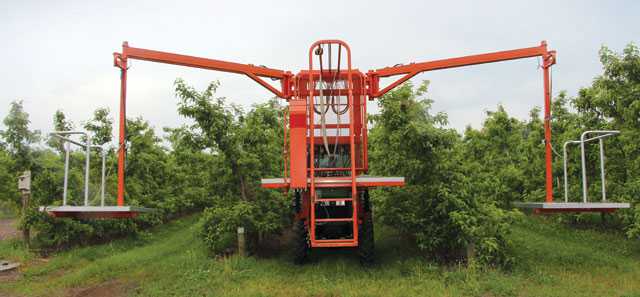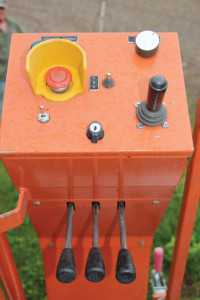New York Apple Grower And Machine Designer Collaborate On Custom Orchard Equipment

Dan LaGasse (left) and Scott VanDeWalle (right) have worked together to create bin trailers, a hedger, a two-row planting plow, a wire-stringing attachment, and standard and over-the-row pruning platforms. (Photo Credit: Christina Herrick)
Mechanization is an increasingly important part of the apple industry as growers seek more efficient ways of completing tasks in high-density orchards. As new equipment is developed to meet the needs of the modern American apple grower, more than just equipment is built. Partnerships are being forged as well.
Dan LaGasse and Scott VanDeWalle are a great example. Dan LaGasse is a machine designer and owner of LaGasse Works in Lyons, NY. VanDeWalle co-owns VanDeWalle Fruit Farm in Alton, NY, with his brother, Marshall. Theirs is a story of how a working relationship has evolved and developed over the years in the heart of New York apple country.
The First Collaboration
LaGasse and VanDeWalle’s first collaboration — a nursery tree digger — was about thirty years ago and started with a drawing on the floor.
“I remember him coming into the shop, I had a piece of chalk and I drew it on the floor and said ‘this is what I’m thinking.’ And he took it back and built something that works. It’s worked since,” VanDeWalle says.
LaGasse and VanDeWalle’s designs for equipment often start on the back of an envelope or a cardboard box. The duo’s early projects included the nursery tree digger, orchard sweepers, and outfitting a tractor with orchard fenders.
“Dan’s very good at taking an idea that I may have or something I’ve seen from other people scribbled on a piece of paper I give to him, and he builds it and it comes back and it seems to work,” VanDeWalle says.
LaGasse and VanDeWalle have worked together to create bin trailers that hold five full bins, a two-row planting plow, a wire-stringing attachment, a hedger, and pruning platforms. LaGasse Works, in collaboration with Marshall VanDeWalle, has also made many improvements to process equipment at the VanDeWalle’s VanDeWalles’ packing house, Wayne County Fruit Sales, as well.

The over-the-row pruning platform includes a 7-by-9 foot platform mounted over the hood of a four-wheel drive tractor and two 4-by-5-foot platforms, suspended by booms. Two workers stand on the main platform and one worker rides on each suspended platform. (Photo credit: Christina Herrick)
Over-The-Row Platform
The pair has collaborated on two pruning platforms prototypes — a platform used for trimming, hand thinning, running wire, or “any real orchard work that’s off the ground,” as VanDeWalle says, and a platform with over-the-row extensions.
“The over-the-row is the most elaborate thing I think we’ve done,” LaGasse says.
The main component of both the simple platform and the over-the-row platform measure 7-by-9 feet and are mounted over the hood of a four-wheel drive tractor. A creeper gear is included in the transmission of the tractor. An overhead frame is included on the platform to attach safety harnesses. Steering and forward motion engagement are controlled from atop the platform. An emergency stop feature is included as well.

A worker can control the forward-motion-speed and steer the machine from on top of the platform. A creeper gear is included on the tractor outfitted with the platform. (Photo credit: Christina Herrick)
With the over-the-row platform, additional 4-by-5-foot platforms are suspended from booms which swing out over adjacent rows when in use and then are lowered to proper pruning height. One worker rides on each suspended platform. Thus, the over-the-row platform can cover two full rows, with four workers.
LaGasse has built several of the single-row platforms under the LaGasse Orchard brand for other area tree fruit growers. The estimated cost for equipping an existing tractor with single-row platform is $12,000. He has also built a hedger for Terence Robinson at Cornell’s Agricultural Research Station in Geneva and for a super-spindle apple grower in New York.
Putting The Platform To Use
VanDeWalle says the original thought was to simply use the pruning platforms for winter pruning. However, they have been put to use quite often in the orchard for hand thinning, building trellis, leader selection, tree training, and summer pruning. VanDeWalle does not use the platform for harvest, given the design of the platform, bin management would be a challenge.
“There’s very few periods in the year when we’re not using it, outside of harvest,” VanDeWalle says. “It’s met all expectations and more, really, we use it for many more things than I ever thought,” VanDeWalle says.
Part of the success, VanDeWalle says, is having employees willing to use the platforms and more mechanized equipment.
“Because it’s not me on the platform. If it wasn’t for them, what Dan’s built for us would be in a hedgerow and not working,” he says.
The introduction of the equipment to the orchard wasn’t easy. LaGasse noted that VanDeWalle’s employees were initially skeptical of using the over-the-row trimming platform — they were afraid that the platform would put them out of a job.
“They worked on it for winter trimming and by the end of winter, they didn’t want to get off of it because it ended up being much easier than trimming on ladders or from the ground,” VanDeWalle says. “They’ve seen how much easier it is, and how much ground they can cover and we keep adding acres and the same people keep trimming more. It’s not as though the work runs out, there’s just more for them to do all the time.”
The end goal, VanDeWalle says, is to add more acres of planting, and keep the same people.
“We feel it’s going to get harder and harder to find good employees so we’d rather treat the handful of employees we have well and expect them to be able to run equipment, like the over-the-row sprayer or the trimming platforms or what not. So far we’ve been able to plant a lot of acres and keep up with it all,” he says.

A worker at Dan LaGasse’s shop, LaGasse Works in Lyons, NY, welds a piece of a harvester that LaGasse designed for New York hops growers. (Photo Credit: Richard Jones)
Before You Buy That Equipment
Growers may think they’re ready to add a trimming platform or a hedger, but VanDeWalle cautions that standardization of your orchard system is vital to the success of introducing equipment into your orchard. Whether it’s super-spindle, tall spindle, vertical axis, etc. — stick with one training system and one set spacing.
“The machines that can be built can only be adjustable to so many systems,” he says. “If you try to have too many different systems in the way you design your farm, you’ll never really be happy with the way any unusual piece of equipment will run because there are too many variables in it all.”
LaGasse says the first purchase a grower should consider is a trimming platform that could have multiple uses, such as and then move to a hedger, and then a harvesting platform — based on labor savings and efficiencies.
One thing is for sure, orchard mechanization is not going away VanDeWalle says.
“I think in the future, it’ll be pretty necessary to have something like that only because when you first start working on a platform — that’s usually what most people start with — you can get 30% to 40% labor savings initially. That’s fewer pickers, much less housing and a lot of other things that start to add up real fast,” he says. “It’s not only the labor savings, which is big, it’s the diesel fuel, it’s the hours on the tractor, it just all starts to add up.”
As for now, LaGasse and VanDeWalle are working on a bin carrier for VanDeWalle’s packing house that will carry 36 empty bins.
“Every year Scott comes to me with a new project,” LaGasse says. “The best way to do business is to establish long-term relationships.”
Efficiency By The Numbers
Scott VanDeWalle and Dan LaGasse’s work has been featured in articles in the New York Fruit Quarterly by Mario Miranda Sazo, a fruit Extension specialist, Cornell Cooperative Extension, Lake Ontario Fruit Program.
“Dan LaGasse had been working in Wayne County for many years, but it was through his collaboration with Scott VanDeWalle, where all this (mechanization) began to happen. They began with the idea of the mounted platform, the hedger, and more recently the use of the over-the-row platform,” Miranda Sazo says.
Mirando Sazo studied the efficiencies of pruning on a pruning platform in a high-density orchard. He found pruning time was reduced from 1.26 minutes per tree to 0.92 minutes per tree when workers used a platform. The platform reduced labor cost by approximately 27% to 30%. In his research, a motorized platform could save growers $102 per acre for dormant pruning, $104 per acre for hand thinning, and $45 per acre for trellis installation.
Miranda Sazo says that LaGasse and VanDeWalle have been very supportive of Cornell Cooperative Extension, whether it be to host meetings at the orchard, conduct hedging trials, time labor efficiencies with platforms, or to share progress on their collaborations, including the pruning platforms.
“I feel very lucky to have that type of cooperator working for us in our industry,” Miranda Sazo says. “They’re very humble people, they love to work together. They are very successful in their own businesses, but at the same time they enjoy challenging each other with new things that are not built, but they know they need to be built. It’s a challenge for them.”
See “Work Smarter, Not Harder” in this issue for Miranda Sazo’s advice to growers on how to maximize efficiency in the orchard.
Munckhof Sprayer
Dan LaGasse and Scott VanDeWalle’s partnership extends beyond equipment design. VanDeWalle helped secure LaGasse’s distribution of the Munckhof 3-Row Orchard Sprayer in the Northeast.
LaGasse became interested in the Munckhof 3-Row Orchard Sprayer after doing some research on the company following the International Fruit Tree Association 2012 Summer Tour in Quebec.
“I thought it was something our larger growers could really take advantage of,” LaGasse says.
He noticed that there were no American dealers. So, LaGasse contacted the company to see if he could be a dealer. Representatives from Munckhof visited Wayne County, NY, to meet apple growers and to visit LaGasse Works.
On a trip to Interpoma in Italy, LaGasse again got a chance to see the sprayer up close and meet with company representatives.
“Scott said he trusted my judgment and if I felt it was well-built, he’d buy one from me,” says LaGasse.
VanDeWalle is so impressed with the sprayer, he’s ordered another one.
“The time savings is just phenomenal. You can have one guy in a three-row sprayer and he sprays as many acres as three other guys in conventional sprayers and tractor. The over-the-row sprayer has been a big advantage.”










